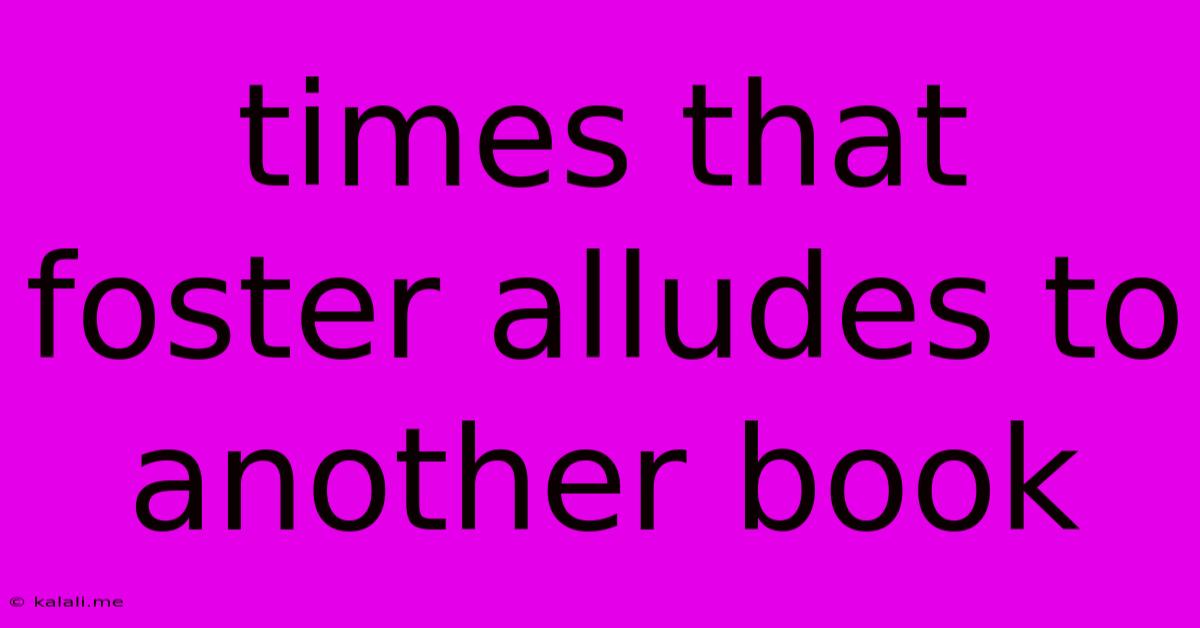Times That Foster Alludes To Another Book
Kalali
Jun 01, 2025 · 3 min read

Table of Contents
When Foster Alludes: Tracing the Literary Echoes in "How to Read Literature Like a Professor"
Thomas Foster's How to Read Literature Like a Professor isn't just a guide to understanding literary techniques; it's a vibrant tapestry woven with allusions to countless other books. This isn't mere name-dropping; these references enrich the text, providing concrete examples and deepening our appreciation for the interconnectedness of literature. Understanding these allusions unlocks a deeper layer of meaning within Foster's work itself.
This article will explore several instances where Foster alludes to other books, demonstrating how these references function to clarify complex concepts and enhance the reader's understanding of literary devices. We'll see how Foster uses these allusions to build a compelling narrative, illuminating his points with familiar stories and characters.
Shakespeare: The Undisputed King of Allusions
It's impossible to discuss allusions in Foster's book without mentioning Shakespeare. Shakespeare's works serve as a bedrock for many literary conventions and are repeatedly referenced throughout How to Read Literature Like a Professor. Foster uses Shakespearean plays to illustrate points on various literary elements, from symbolism (the recurring imagery in Hamlet) to archetypes (the tragic hero in Macbeth). These allusions aren't simply illustrative; they act as shared cultural touchstones, allowing Foster to communicate complex ideas more effectively to his audience. He assumes a level of familiarity with Shakespeare, leveraging that shared knowledge to create a more engaging and insightful reading experience. Consider how discussing Hamlet's procrastination provides a clear and relatable example of character development and internal conflict.
Biblical Allusions: A Foundation of Western Literature
Foster frequently draws parallels between contemporary literature and biblical narratives. He uses these allusions to unpack themes of sacrifice, redemption, and temptation, demonstrating how these archetypal stories resonate across various cultures and time periods. References to the Bible, particularly the Old Testament, help illustrate recurring literary motifs and symbolic imagery. The use of biblical allusion enriches the analysis, showing how even seemingly modern stories often rely on ancient narratives to build meaning. This emphasizes the enduring power of biblical storytelling and its continued influence on contemporary literature.
Mythological Allusions: Exploring Universal Themes
Classical mythology also plays a significant role in Foster's allusions. He uses myths to highlight the enduring presence of archetypes and symbols in literature. By referencing Greek and Roman mythology, Foster reveals how writers employ these established narratives to explore universal themes such as love, loss, ambition, and fate. Understanding these allusions adds another dimension to the interpretive process, allowing readers to decipher deeper meanings embedded in literary works. These allusions further emphasize the cyclical nature of storytelling and the constant reimagining of ancient narratives within contemporary contexts.
The Power of Intertextuality: Connecting the Literary Dots
Foster's skillful use of allusion demonstrates the principle of intertextuality—the interconnectedness of literary works. He effectively illustrates how literature builds upon itself, with authors constantly drawing inspiration from and engaging in dialogue with previous works. This interconnectedness makes literature a richer and more rewarding experience for those who can recognize and appreciate these literary echoes. Understanding these allusions offers a more holistic understanding of literary history and its evolution.
In conclusion, the allusions within How to Read Literature Like a Professor aren't mere decorative elements; they are integral to the book's effectiveness. By referencing a wide range of literary works, Foster creates a dynamic and engaging reading experience that deepens our understanding of literary techniques and the enduring power of storytelling. These allusions reinforce the interconnected nature of literature and encourage readers to actively engage with the rich tapestry of literary traditions.
Latest Posts
Latest Posts
-
How Do You Tell If A Head Gasket Is Blown
Jun 03, 2025
-
Outside Light Bulb Wont Twist Out
Jun 03, 2025
-
How Many Four Sided Figures Appear In The Diagram Below
Jun 03, 2025
-
How To Write Matrices In Latex
Jun 03, 2025
-
Jiffy Lube Oil Pan Gasket Replacement Cost
Jun 03, 2025
Related Post
Thank you for visiting our website which covers about Times That Foster Alludes To Another Book . We hope the information provided has been useful to you. Feel free to contact us if you have any questions or need further assistance. See you next time and don't miss to bookmark.